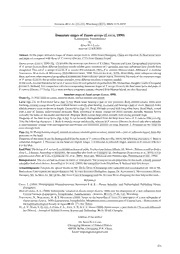
Immature stages of Faunis aerope (Leech, 1890) PDF
Preview Immature stages of Faunis aerope (Leech, 1890)
Atalanta 42 (1-4): 221-222, Würzburg (2011), ISSN 0171-0079 Immature stages of Faunis aerope (Leech, 1890) (Lepidoptera, Nymphalidae) by Song-Yun Lang received 12.XII.2010 Abstract: In this paper, immature stages of Faunis aerope (Leech, 1890) from Chongqing, China are reported. Its final instar larva and pupa are compared with those of F. eumeus (DrurY, 1773) from Hainan Island. Faunis aerope (Leech, 1890) (fig. 12) inhabits the montane rain forests of S. China, Vietnam and Laos. Geographical populations of F. aerope (Leech) from different localities usually exhibit great variations of † genitalia, and four subspecies have already been recognised. They are F. a. aerope (Leech), F. a. excelsa (FruhstorFer, 1901), F. a. centrala MonastYrskii, 2004 and F. a. montana nakaMura, Wakahara & MiYaMoto, 2010 (MonastYrskii, 2004; nakaMura et al., 2010). More likely, some subspecies among them, and even other unnamed geographical populations deserve distinct species status. Therefore, the study of the immature stages of F. aerope (Leech), the so called aerope-complex, from different localities is urgently needed. In this work, ova and first-instar larvae of F. aerope (Leech) were gathered on palms from Mt. Simianshan, Jiangjin County, Chongqing [former E. Sichuan]. For comparison with the corresponding immature stages of F. aerope (Leech), the final instar larva and pupa of F. eumeus (DrurY, 1773) (fig. 11), a more southern congeneric species, obtained from Hainan Island, are also illustrated. Immature stages of Faunis aerope (Leech, 1890) Ovum (fig. 1): Pure white in colour, round in shape, surface smooth and polish. Larva (figs. 2-6, 8): First-instar larva (figs. 2, 8a): Black head, bearing a pair of tiny processes. Body entirely creamy white after hatching, turning orange dorsally and reddish brown ventrally after feeding; its caudal end bearing a pair of short, blackish forks; whitish primary setae moderate in length. Grown larva (figs. 3-6, 8b-g): Densely covered with long white hairs. Head black, armed with a pair of dumpy, multi-furcated processes. Body cylindrical in shape, orange red above spiracles dorsally, blackish brown ventrally; the forks on the caudal end blackish. Prepupa: Body colour deep yellow dorsally with strong greenish tinge. Diagnosis of the final instar larva (figs. 6, 8g): It can be easily distinguished from the final instar larva of F. eumeus (DrurY) (fig. 7) by the following characters: 1. Body is entirely orange red dorsally, whereas in F. eumeus (DrurY) its dorsal side above spiracles is predominantly orange with intersegmental membranes and transverse grooves on terga blackish. 2. Processes on the head are more strongly built. Pupa (fig. 9): Plump banana-shaped, smooth in texture, emerald green in colour, armed with a pair of yellowish-tipped, horn-like processes on the head. Diagnosis of the pupa: It can be distinguished from the pupa of F. eumeus (DrurY) (fig. 10) by the following characters: 1. Body is somewhat elongated. 2. Processes on the head are slightly longer. 3. Cremaster is yellowish tinged, whereas in F. eumeus (DrurY) it is sky blue. Food Plant: The larvae of F. aerope (Leech) feed on leaves of palm, Trachycarpus fortunei (Hook.) H. WenDL., Palmae as well as Smilax china L., Liliaceae. According to literatures, the caterpillar also feeds on Coelogyne sp., Orchidaceae (nakaMura et al., 2010), Cycas panzhihuaensis Zhou & Yang, Cycadaceae (Yu et al., 2009), Musa spp., Musaceae and Pandanus spp., Pandanaceae (chou, 1994). Biological notes: The ova are laid in cluster on leaves of food plants. The young larvae are gregarious. In this work, a finally pupated caterpillar had seven instars. According to Yu et al. (2009), the caterpillars from Panzhihua, S. Sichuan have five instars. Acknowledgements: I express my special thanks to Mr. he-Li Deng (Chongqing) who supported and accompanied my trip to Mt. Simianshan. I also express my sincere thanks to Mr. Yutaka inaYoshi (Tochigiken, Japan), Dr. aLexanDer L. MonastYrskii (Hanoi, Vietnam), Mr. ai-Ming Li, Mr. Qi Ma, Mr. Feng chen (Chongqing) and Dr. xuejian Wang (Guiyang) for their help in this work. References chou, i. (1994): Monographia Rhopalocerorum Sinensium 1 & 2. - Henan Scientific and Tech nological Publishing House, Zhengzhou. MonastYrskii, a. L. (2004): infraspecific variation in Faunis aerope (Leech, 1890) and the description of a new subspecies from Central Vietnam (Lepidoptera, Nymphalidae, Amathusiinae). - Atalanta 35 (1/2): 37-44, 1 pl., Würzburg. nakaMura, n., Wakahara, h. & t. MiYaMoto (2010): Notes on the butterflies of Laos (V): description of a new subspecies of Faunis aerope (Leech, 1890) (Lepidoptera, Nymphalidae, Morphinae) from a montane area of Central Laos. - Transactions of the Lepidopterological Society of Japan 60 (4): 277-284, Tokyo. Yu, Z. Y., Yang, Y. Q., Liu, j., chen, c. L., guo, x. x. & L. L. gong (2009): Faunis aerope, a pest feeds on Clycas panzhihuaensis [in Chinese]. - Journal of Sichuan Forestry Science and Technology 30 (3): 80-84, Chengdu. Address of the author Dr. Song-Yun Lang Chongqing Museum of Natural History 400700, Beibei, Chongqing, P. R. China Email: [email protected] 221 Fig. 1-6, 8, 9, 12: Faunis aerope (Leech, 1890), (1) A cluster of ova on the underside of a palm leaf (photographed by ai-Ming Li); (2) L1 larvae and two hatching ova (photographed by ai-Ming Li); (3) L2 larva, dorsolateral side; (4) L5 larva, dorsolateral side; (5) L6 larva, lateral side; (6) L7 larva, dorsal side; (8) L1-L7 head, front side; (9) pupa, dorsal, lateral, ventral; (12) imago, Mt. Simianshan, Jiangjin, Chongqing. Fig. 7, 10, 11: Faunis eumeus (DrurY, 1773), (7) final instar larva, dorsal side. (10) Pupa, dorsal, lateral, ventral; (11) imago, Mt. Diaoluoshan, Lingshui, Hainan. Scale bar in fig. 4-6: 10 mm, in fig 8: 1 mm. 222
